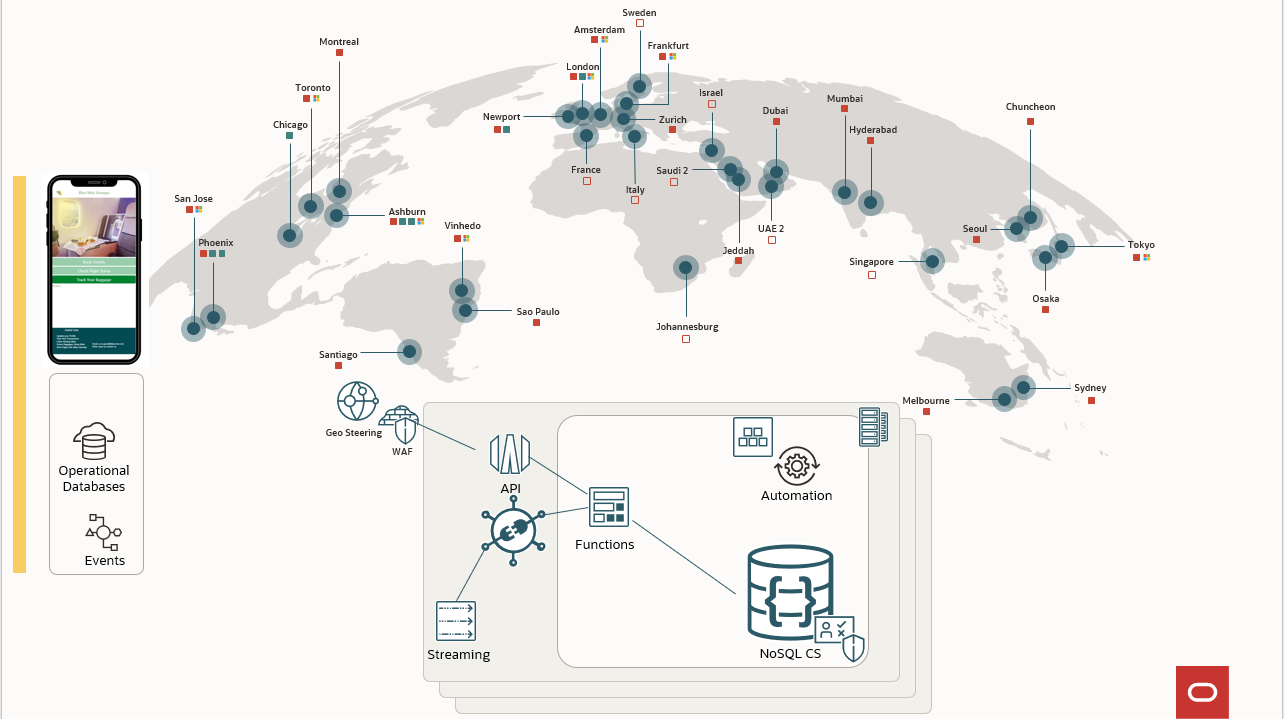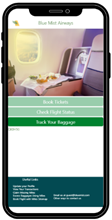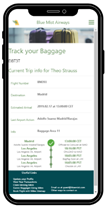Why this app?
In recent years, mobile apps have given consumers unprecedented access to what used to be considered “back-office” data. In fact, consumer access to back-office data is an emerging “trend.” This data has been tapped into, reformatted, and displayed in an easy-to-understand JSON format. To handle this increase in load, systems are scaled horizontally and made resilient to failures via high availability and replication. We embarked on building an application to demonstrate some of the business drivers as well as some of the key architectural factors in a baggage handling system – a “back office” system that is now available to many travelers today. We have taken pieces of this application and stuck them into a Hands-On-Lab (LiveLab).
Technical Architecture
From a technical perspective, we will demonstrate a geo-distributed app with predictable low latency, with access from any mobile device or web browser.
You will:
- Run a geo-distributed application providing information in real-time from any location in the world
- Appreciate why Oracle NoSQL Database Cloud Services and OCI are compelling
- Explore the breadth of Oracle Cloud Technologies such as Visual Builder Studio, Digital Assistant, Apiary, OCI API Gateway, OCI Geo-Steering Traffic Management, Web Application Firewall, and see a reference architecture with Oracle Cloud Technologies
Back-end architecture of the baggage handling system
The multi-tier application has been the most used architecture pattern for decades. The multi-tier pattern provides good guidelines for you to follow to ensure decoupled and scalable application components that can be separately managed and maintained.
The following diagram is explaining this architecture in this application context:

Service Connector Hub is a cloud message bus platform that offers a single pane of glass for describing, executing, and monitoring the movement of data between services in Oracle Cloud Infrastructure.
The API Gateway service enables you to publish APIs with private endpoints that are accessible from within your network, and which you can expose with public IP addresses if you want them to accept internet traffic. The endpoints support API validation, request and response transformation, CORS, authentication and authorization, and request limiting.
Oracle Functions is a serverless, multi-tenant, highly scalable, on-demand, Functions-as-a-Service platform. It is built on enterprise-grade Oracle Cloud Infrastructure and powered by the Fn Project open-source engine. Use Oracle Functions (sometimes abbreviated to just Functions) when you want to focus on writing code to meet business needs.
Oracle NoSQL Database Cloud Service is a severless database cloud service that is designed for database operations that require predictable, single-digit millisecond latency responses to simple queries. NoSQL Database Cloud Service allows developers to focus on application development rather than setting up cluster servers, or performing system monitoring, tuning, diagnosing, and scaling.
The features of these services enable you to build a serverless production application that is highly available, scalable, and secure. Your application can use thousands of servers, however, by leveraging this pattern you do not have to manage a single one.
In addition, by using these managed services together you gain the following benefits:
- No operating systems to choose, secure, patch, or manage.
- No servers to size, monitor, or scale-out.
- No risk to your cost by over-provisioning.
- No risk to your performance by under-provisioning.
Learn and Discover why NoSQL Cloud Services and OCI native services are compelling
In this series of LiveLabs, we will explain in detail this architecture and how we used this pattern when building the baggage claim application. You will learn how easy is to build this application.
LiveLab 1 – Discover Serverless Apps Using Oracle NoSQL Cloud – level beginner.
- Create NoSQL Tables, Load Tables
- Build a simple node.js program in order to understand how to use the Oracle NoSQL SDK – REST technical API
- Build a simple node.js program in order to simulate the Business REST API Endpoints
LiveLab 2 – Intermediate level LiveLab will feature functions – coming soon.
- Build a Node.js function (function is our serverless framework) to insert JSON data into a NoSQL table, triggered manually.
- Build a Node.js function implementing serverless API functions on the back end, and an API gateway providing front-end access to those functions.
- Build a Python function to process and load data, and then reference that function in a service connector (Service Connector Hub) to process and move data from Streaming to a NoSQL table in real-time.
LiveLab 3 – Advanced level Livelab will feature Streaming and API gateway – coming soon.
- You will learn to How to Deploy this application using all of the services listed above.
Summary
Jump over our LiveLabs and start building your first geo-distributed application.
Explore More:
- Scan the QR code to get the mobile app or simply point your mobile browser to ndcsdemo.com
- Read this blog to learn how your customers can save as much as 72% over AWS DynamoDB
- Learn more about the Microservices Architecture
|
|
|
| * Hamburger menu in top right corner to generate new random trip to track baggage |



